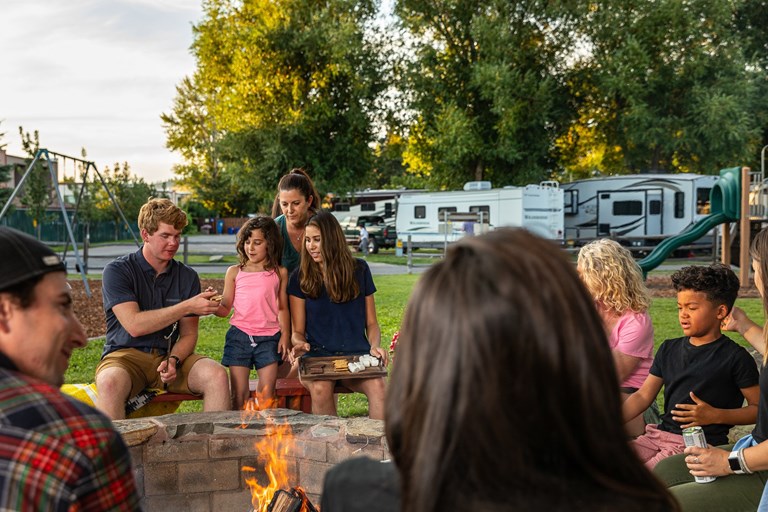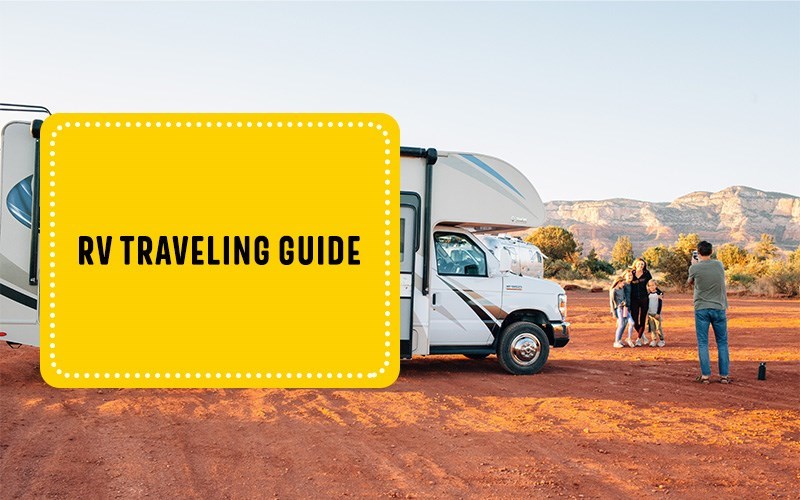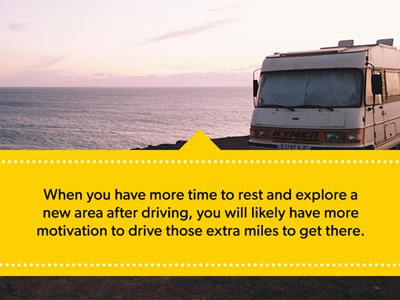Your cart is empty!
Make checkout easy by booking all your reservations at once. Add your sites from different campgrounds into your shopping cart* and then choose checkout.


RV camping is adventurous, exciting and relaxing. Improving your driving experience with some planning strategies can enhance your travels. Whether you love the spontaneity of discovering new places or enjoy researching each travel destination, detail and activity, planning your RV route can help you make the most of every adventure.
Knowing which roads to take, how far to drive each day, when to arrive at your destinations and how long you will stay can help you have a fantastic time. With the right RV travel strategies, you can ensure you have plenty of time to relax, explore and fully experience each destination. This RV traveling guide contains RV traveling tips for beginners and experienced campers to help you plan a memorable RV vacation.
The 3-3-3 rule is a fantastic strategy for RV travelers. When you travel according to the 3-3-3 rule, you drive 300 miles or fewer per day, arrive at your destination before 3 p.m. and stay at your destination for at least three days.
Vacationing and exploring new places is fun, but driving is probably your least favorite part of RV camping. Traveling in a camper requires a slower driving speed and increased focus, so it's important to ensure you stay energized and alert. Prevent yourself from burning out by driving no more than 300 miles in one day. Camping at a location at different points between home and your final destination can help you rest and energize before driving the entire distance to your final destination.
The best time to arrive at your destination is between the hours of 10 a.m. and 3 p.m. because most campground attendants work these hours. Arriving before a campground closes at 3 p.m. lets you check in easily and ask the attendants any questions you may have. This is especially helpful when you are staying at an exciting new location and want to learn about the campground and surrounding activities. Always check with your destination campground about their individual check-in time to make sure you don't arrive to early before they allow arrivals. This will avoid disappointment at having to wait.
Arriving before 3 p.m. can also help you make the most of your first day at a destination. This gives you enough time to park your RV, get settled at your campsite, check out the surrounding area and have some dinner at a local restaurant before it gets dark.
Staying at your destination for at least three days after driving a long distance gives you enough time to rest, explore the area, enjoy the wilderness and have fun. Traveling is a more fulfilling experience when you allow yourself time to relax and take in the peacefulness of the great outdoors.
A trip is also more memorable when you have time to plan fun activities and try new things. When you take the time to drive to a destination, you should also give yourself enough days to truly experience and enjoy it.
Everyone is unique, so you and your friends or family may enjoy a different RV traveling style. If the 3-3-3 rule doesn't fit your camping schedule or preferences, consider the following alternative travel strategies:
If you enjoy quick weekend getaways or like to stop at multiple places on your way to a final destination, you may prefer to drive 200 miles or less, arrive before 2 p.m. and plan to stay for two nights. Since you drive fewer miles to reach your destination, two nights is plenty of time to enjoy your time once you arrive at each new location.

You can also increase the numbers rule. If you plan to stay at your destination for four or more days, driving 400 miles is worthwhile. When you have more time to rest and explore a new area after driving, you will likely have more motivation to drive those extra miles to get there. If you follow the 4-4-4 rule, you drive 400 or fewer miles per day, arrive at each destination before 4 p.m. and stay at each destination for at least four days.
The 3/300 rule applies exclusively to your driving time. When you follow the 3/300 rule, you drive 300 miles or until 3 p.m. Whichever option occurs first determines where you stop. For example, if you only drive 200 miles but notice it's almost 3 p.m., stop at the nearest location. This is a fun option if you want to try something new or practice being spontaneous. You may even discover a new favorite spot.
Some RV travelers prefer to arrive at their final travel destination as soon as possible. To accomplish this, they drive as many miles as they can safely complete in a day. This ambitious goal may seem appealing if you are excited to reach your final destination, but safety is essential when RV traveling. Only implement the ASAP strategy if you feel safe and comfortable doing so.
Avoid driving more than 15 hours per day, and stop at a safe location immediately if you start to feel tired, frustrated or unfocused. Limiting your driving hours for safety can help you prevent vehicle accidents and help you maintain a positive mood to fully enjoy your trip.
Driving an RV requires increased focus and planning to ensure safety. To practice safe RV traveling, consider the following unwritten rules of RV camping:
Planning your travel time with calculated mileage can reduce stress, creating a more relaxed and enjoyable traveling experience. You can use an online map to calculate how far you will need to drive and how long it will take you to reach your main destination.
Planning your route in advance is also an excellent opportunity to choose fun destinations and restaurants to stop at along the way, and it's an easy way to locate the most convenient gas stations so you know when to stop for fuel.
Keep track of the weather forecast to avoid unsafe driving conditions. Changing your travel plans when the forecast predicts ice, snow, heavy rain or excessive wind can save your life and prevent RV damage. Downloading a few different weather apps can help you receive accurate predictions of weather conditions.
One of the most important tips for driving an RV is to memorize your RV's specifications and dimensions. Knowing your RV dimensions and specifications can help you take the safest routes and locate appropriate stopping points on your journey. The United States Department of Transportation institutes legal RV limits, restricting certain widths on different roadways, so you should always check your route's legal limits before embarking on your journey.
It's essential to know your RV's height, length and width because this knowledge can help you avoid roads, tunnels and bridges that are not safe for RV travel. It can also help you choose destinations based on which RV parks can accommodate your RV's height and length.
Planning your RV routes, destinations and driving times can help you make the most of your next trip. KOA is a fantastic destination for RV campers looking to relax, have fun and explore exciting new places.
Missoula KOA Holiday offers fantastic camping options for RV travelers. KOA's Pull Thru RV Sites offer partial and full hookups for optimal comfort. When you stay at Missoula KOA Holiday, you can also enjoy convenient amenities and exciting campground recreational activities such as mini-golf, pedal cart rentals and swimming pools. Book a stay at KOA to start your RV adventure.
That doesn't mean this area has to always be empty. When you start reviewing camping options, your history will display here to help compare sites and find the best stay. You will be able to share your stay information with friends or family and save it for a later time if you have a KOA Account.
Make checkout easy by booking all your reservations at once. Add your sites from different campgrounds into your shopping cart* and then choose checkout.